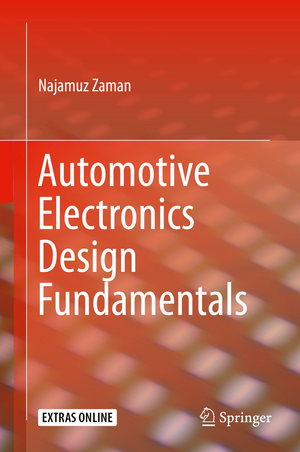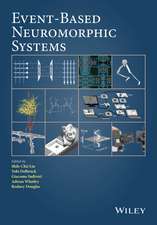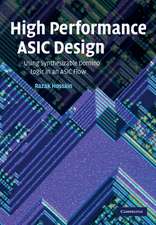Automotive Electronics Design Fundamentals
Autor Najamuz Zamanen Limba Engleză Hardback – sep 2015
| Toate formatele și edițiile | Preț | Express |
|---|---|---|
| Paperback (1) | 498.71 lei 38-44 zile | |
| Springer International Publishing – 22 oct 2016 | 498.71 lei 38-44 zile | |
| Hardback (1) | 691.17 lei 38-44 zile | |
| Springer International Publishing – sep 2015 | 691.17 lei 38-44 zile |
Preț: 691.17 lei
Preț vechi: 897.62 lei
-23% Nou
Puncte Express: 1037
Preț estimativ în valută:
132.28€ • 138.14$ • 109.67£
132.28€ • 138.14$ • 109.67£
Carte tipărită la comandă
Livrare economică 07-13 februarie 25
Preluare comenzi: 021 569.72.76
Specificații
ISBN-13: 9783319175836
ISBN-10: 3319175831
Pagini: 288
Ilustrații: XI, 262 p. 234 illus., 229 illus. in color.
Dimensiuni: 155 x 235 x 20 mm
Greutate: 0.68 kg
Ediția:1st ed. 2015
Editura: Springer International Publishing
Colecția Springer
Locul publicării:Cham, Switzerland
ISBN-10: 3319175831
Pagini: 288
Ilustrații: XI, 262 p. 234 illus., 229 illus. in color.
Dimensiuni: 155 x 235 x 20 mm
Greutate: 0.68 kg
Ediția:1st ed. 2015
Editura: Springer International Publishing
Colecția Springer
Locul publicării:Cham, Switzerland
Public țintă
Professional/practitionerCuprins
Introduction.- Module Architecture.- Autonics.- CAN Communication.- Distributed Computing & Systems Architecture.
Recenzii
It is the opinion of this reviewer that the book, as the title suggests, is a book on vehicular electronics design fundamentals, and is an excellent book from that perspective. The book seems more valuable for a somewhat advanced level vehicular electronics class (undergraduate or graduate) rather than for a basic course on the subject involving fundamental principles and theory, which is understandable. The book encompasses the automotive electronics modular electronics partitioning. The first chapter introduces the electronics architecture with interesting contents. The reader may find the material somewhat intriguing and hopefully will keep on reading as interest grows with each step at every sentence, paragraph or page. Chapter One finishes with a real world survey of a Nissan Quest minivan modular architecture. Chapter Two delves into a typical electronics module, and is an excellent example of good engineering understanding of each essential block. Chapter three !
goes further deep down for each essential block, so that the reader can grasp the basic design criterion. Chapter Four introduces a very basic understanding of software modes that are essential for the vehicle battery conservation. Chapter Five goes into the real life design of the fundamental block by utilizing OrCAD/PSpice, and TINA simulation software, which is very helpful for academia and industry to understand how the tools are used to crank out the correct design right before it gets incorrect. Chapter Six deals with a glowing example of Lincoln MKC vehicle electronics module overview, CAN bus architecture - really a good introduction of bells & whistles of a modern car. Last chapter introduces the basics of an electromagnetic compliance of a module, and vehicle, and shows how different types of testing are conducted to comply to EMC issues in a radio energy universe. This reviewer believes that it would have been nice if the author included a chapter or two pertai!
ning to electric and hybrid vehicles and also power electronics, since those are now getting more popular nowadays. But given the relatively small size of this book, it is the belief of this reviewer that the author has done an excellent job which also provides the real life experience of the author himself who is from the industry. This reviewer, who also has worked in the industry for many years, can fully relate to this.
Notă biografică
Najamuz Zaman is a Senior Electrical Engineer at Panasonic Automotive Systems Company of America.
Textul de pe ultima copertă
This book explains the topology behind automotive electronics architectures and examines how they can be profoundly augmented with embedded controllers. These controllers serve as the core building blocks of today’s vehicle electronics. Rather than simply teaching electrical basics, this unique resource focuses on the fundamental concepts of vehicle electronics architecture, and details the wide variety of Electronic Control Modules (ECMs) that enable the increasingly sophisticated "bells & whistles" of modern designs. A must-have for automotive design engineers, technicians working in automotive electronics repair centers and students taking automotive electronics courses, this guide bridges the gap between academic instruction and industry practice with clear, concise advice on how to design and optimize automotive electronics with embedded controllers.
Caracteristici
Explains cutting-edge vehicle electronics systems architecture, demonstrating how and why embedded control features have been integrated into designs for greater functionality Explores the internal and external architecture of the Electronic Control Modules (ECMs), describing their functions and nomenclature in detail Demonstrates how to design a typical electronics module, focusing on the hardware and software blocks needed to develop ECMs for automotive applications











